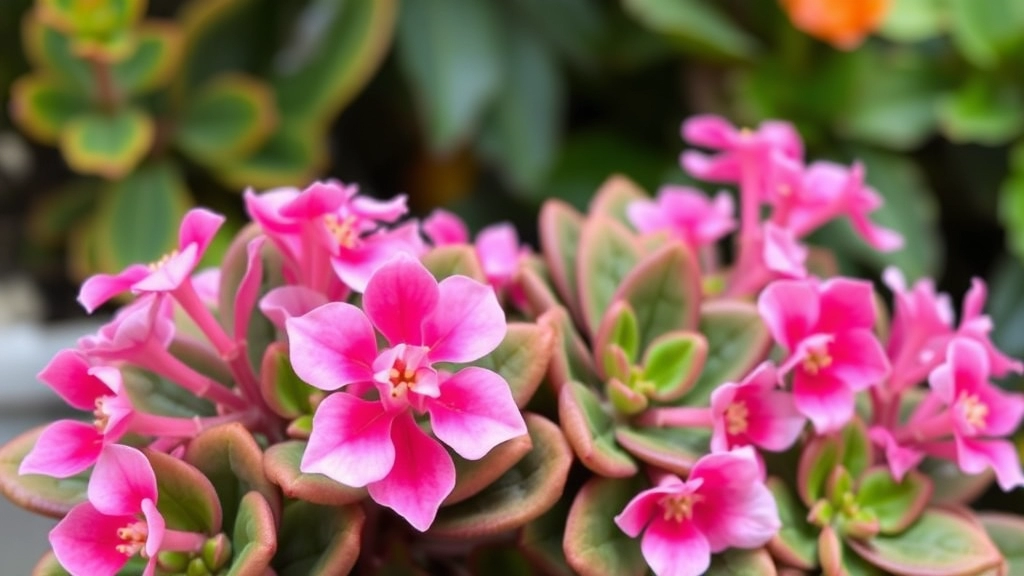Exploring the Wonders of Kalanchoe
As a florist and plant enthusiast, I’m excited to share the wonders of Kalanchoe with you. These vibrant succulents are more than just pretty faces in your garden or home. From their air-purifying prowess to their mood-boosting abilities, Kalanchoes pack a punch when it comes to benefits. Whether you’re a seasoned plant parent or a newbie with a notorious black thumb, these resilient beauties have something to offer. Join me as we explore the colorful world of Kalanchoe – from their low-maintenance care to their surprising medicinal uses. Get ready to discover why these little plants are making big waves in the world of indoor gardening and beyond!
Benefits of Kalanchoe Plants
In this article, we’ll dive into the various benefits of Kalanchoe plants, uncover their air-purifying secrets, and explore their potential health impacts. We’ll also share some easy care tips to keep your Kalanchoe thriving, and reveal why these plants make perfect gifts for any occasion. So, whether you’re looking to spruce up your space, improve your wellbeing, or simply add a splash of color to your life, Kalanchoe might just be the plant you’ve been searching for. Let’s get growing!
Overview of Kalanchoe Plants
Let’s dive into the world of Kalanchoe plants, shall we? These little green wonders have been catching my eye lately, and I bet you’re curious too.
What’s the deal with Kalanchoe?
Kalanchoe (pronounced kal-un-KOH-ee) is a genus of succulents that’s been turning heads in the plant world. They’re not your average houseplant – these guys pack a punch with their vibrant flowers and thick, fleshy leaves.
Origins and Varieties
Hailing from Madagascar and tropical Africa, Kalanchoes have spread their roots far and wide. There are over 100 species in this family, but a handful have become superstars in homes and gardens worldwide.
Key Features:
- Succulent leaves: Store water like a champ
- Colorful blooms: Think reds, pinks, oranges, and yellows
- Compact size: Perfect for small spaces
- Long-lasting flowers: Some bloom for weeks or even months
Why Kalanchoe’s a Game-Changer
Here’s the thing – Kalanchoes aren’t just pretty faces. They’re tough cookies that can handle a bit of neglect (perfect for plant newbies like me). Plus, they’ve got some tricks up their sleeves when it comes to health benefits and air purification.
Growing Kalanchoe: Easy as Pie
These plants are low-maintenance rockstars. They don’t need much water, love bright light, and can thrive in average room temperatures. It’s like they were made for busy people who still want a touch of nature in their lives.
Kalanchoe in Action
I’ve seen Kalanchoes brighten up office desks, add a pop of color to living rooms, and even steal the show in outdoor gardens. They’re versatile little fellas that can fit into almost any space.
The Bottom Line
Kalanchoe plants are more than just a pretty face in the succulent world. They’re easy to care for, come in a rainbow of colors, and might just be the perfect plant for folks who think they don’t have a green thumb. Trust me, if I can keep one alive, anyone can!
So, ready to give Kalanchoe a shot? Stick around, and we’ll dig deeper into why these plants are becoming the talk of the town.
Health Benefits of Kalanchoe
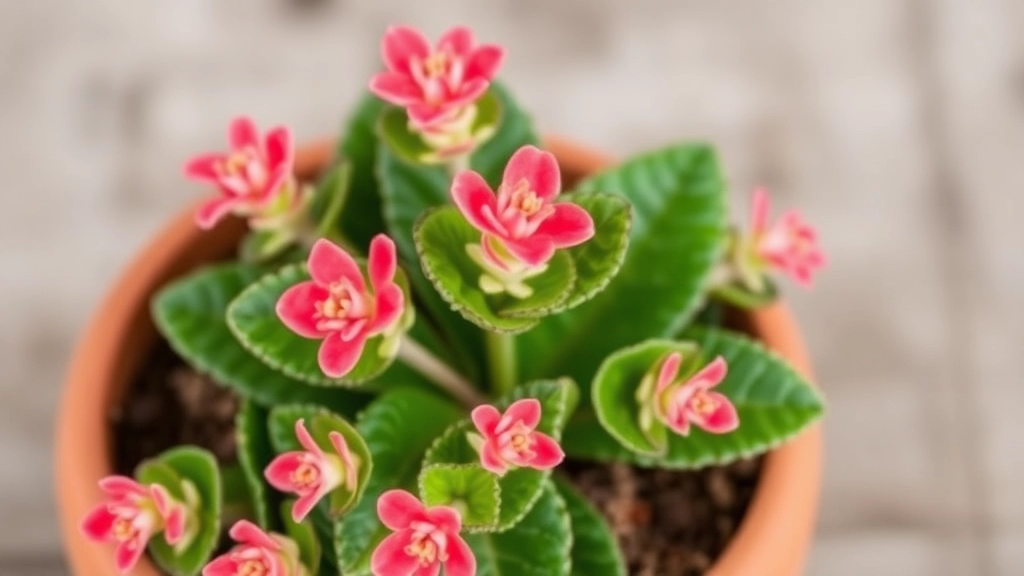
Kalanchoe plants aren’t just pretty faces in your home â they’re health powerhouses too.
Let’s dive into the good stuff these succulents bring to the table.
Air Quality Boost
Ever feel like your room needs a breath of fresh air? Kalanchoe’s got your back.
These little green buddies are natural air purifiers, sucking up nasty toxins and pumping out clean O2.
Stress Buster
Feeling wound up? Kalanchoe might help you chill out.
Just having them around can lower stress levels. It’s like nature’s chill pill, but prettier.
Immune System Helper
Your body’s defense system could use a friend, and Kalanchoe’s raising its hand.
Some folks swear by its immune-boosting properties. Worth a shot, right?
Sleep Aid
Struggling to catch those Zs? Kalanchoe in your bedroom might help.
It’s said to improve sleep quality. Sweet dreams, indeed.
Mood Lifter
Feeling a bit down? Kalanchoe’s vibrant colours might perk you up.
It’s like having a little sunshine indoors, even on gloomy days.
Skin Health
Got some minor cuts or burns? Kalanchoe juice might help soothe them.
Always check with a doc first, though. Safety first, folks.
Respiratory Support
Breathing a bit rough? Kalanchoe might lend a hand.
Some say it helps with respiratory issues. Worth looking into, I reckon.
Remember, while Kalanchoe’s got some cool health perks, it’s not a miracle cure.
Always chat with your doc before using it for any health stuff.
But hey, even if it’s just brightening up your space, that’s a win for your wellbeing, right? If you’re interested in exploring more about Kalanchoe’s health benefits, check out our article on the health benefits of Kalanchoe pinnata. And for those curious about its traditional uses, you might want to read about Kalanchoe pinnata’s medicinal uses.
Air Purification Properties
Listen up, folks. Let’s chat about Kalanchoe’s air-cleaning superpowers. These little green warriors aren’t just pretty faces; they’re working overtime to freshen up your space.
Here’s the deal:
- Kalanchoe plants are natural air purifiers. No fancy gadgets needed.
- They suck up nasty chemicals floating around your home.
- We’re talking about stuff like formaldehyde and benzene. Yuck, right?
But here’s where it gets interesting:
Kalanchoe doesn’t just filter air. It’s like a 24/7 air freshener that never runs out. How cool is that?
Now, you might be thinking, “Alex, come on. All plants do this.” And you’re not wrong. But Kalanchoe? It’s in a league of its own.
Why? Because it’s tough as nails. It keeps cleaning even when other plants would’ve thrown in the towel.
Here’s a quick breakdown:
- It works day and night.
- It doesn’t need much water.
- It thrives in most indoor conditions.
So, you’re getting non-stop air purification without breaking a sweat.
But here’s the kicker: Kalanchoe doesn’t just clean your air. It makes your space feel alive. It’s like having a tiny, silent roommate that’s always on cleaning duty.
And let’s be real – who doesn’t want cleaner air? Whether you’re working from home, chilling with family, or just trying to get a good night’s sleep, better air quality makes everything better.
So, next time you’re looking at your Kalanchoe, remember: it’s not just sitting there looking pretty. It’s actively making your life better, one breath at a time.
Bottom line: Kalanchoe’s air purification properties are the real deal. It’s like having a personal air-cleaning squad, working ’round the clock to keep your space fresh and healthy.
Medicinal Uses of Kalanchoe
Ever wondered if that pretty succulent on your windowsill could be more than just eye candy?
Well, let me tell you about the medicinal uses of Kalanchoe.
This plant’s not just a looker – it’s got some serious health chops.
First off, Kalanchoe’s been used in traditional medicine for ages.
People have turned to it for all sorts of ailments.
Got a nasty cut or burn? Kalanchoe might help.
Some folks swear by its anti-inflammatory properties.
It’s like nature’s own little first-aid kit.
But here’s where it gets really interesting:
Some studies suggest Kalanchoe could have cancer-fighting potential.
Now, I’m not saying it’s a miracle cure – but it’s definitely worth keeping an eye on.
Kalanchoe’s also been used to treat respiratory issues.
Feeling a bit wheezy? This plant might offer some relief.
And for those of us battling high blood pressure, Kalanchoe could be a natural ally.
Some people use it to help manage their blood sugar levels too.
But here’s the thing – always chat with your doc before trying any new treatments.
Natural doesn’t always mean safe for everyone.
So, next time you’re watering your Kalanchoe Tomentosa, remember:
You’re not just tending to a pretty plant.
You’re nurturing a potential medicine cabinet in a pot.
Pretty cool, right? If you’re interested in learning more about different Kalanchoe species, check out the Kalanchoe Blossfeldiana, another popular variety.
Kalanchoe in Home Decor
Let’s chat about how Kalanchoe can jazz up your living space. These little beauties aren’t just pretty faces; they’re versatile decorating powerhouses.
Splash of Colour
First off, Kalanchoe plants are like nature’s paint palette. They come in a rainbow of colours – reds, pinks, oranges, yellows, you name it. Want to brighten up a dull corner? Pop a Kalanchoe there. Need a centrepiece for your dining table? A cluster of these in different hues will do the trick.
Size Matters (But Not Really)
Here’s the cool thing: Kalanchoe plants come in all sizes. Got a tiny apartment? No worries. A small Kalanchoe on your windowsill can add that touch of green without taking up precious space. For those with more room to play, larger varieties can make a statement on side tables or as floor plants.
Versatile Vibes
Kalanchoe fits into pretty much any decor style:
- Modern minimalist? Go for a sleek white pot with a bold red Kalanchoe.
- Boho chic? Mix and match different varieties in colourful, patterned pots.
- Classic elegance? A single Kalanchoe in a ceramic pot can add a subtle touch of sophistication.
Seasonal Decor Made Easy
Here’s a pro tip: use Kalanchoe for seasonal decorating. Their vibrant blooms can match holiday themes without the hassle of constantly buying new decor. Red and white for Christmas, pastels for Easter – you get the idea.
Beyond the Pot
Think outside the box (or pot, in this case):
- Hanging baskets: Some trailing varieties look stunning in hanging planters.
- Terrariums: Mini Kalanchoes work great in glass containers.
- Wall gardens: Create a living wall with different Kalanchoe species.
The Low-Maintenance Luxe Look
Let’s be real – we all want our homes to look fab without the fuss. Kalanchoe delivers on this front. They look high-end but don’t demand constant attention. It’s like having a personal stylist for your home that doesn’t need paying.
In a nutshell, Kalanchoe plants are your secret weapon for home decor. They’re versatile, colourful, and low-maintenance – perfect for adding that touch of life to any room. Whether you’re a decor newbie or a seasoned pro, Kalanchoe’s got your back. So go ahead, let these little plants work their magic in your space!
Low Maintenance and Easy Care
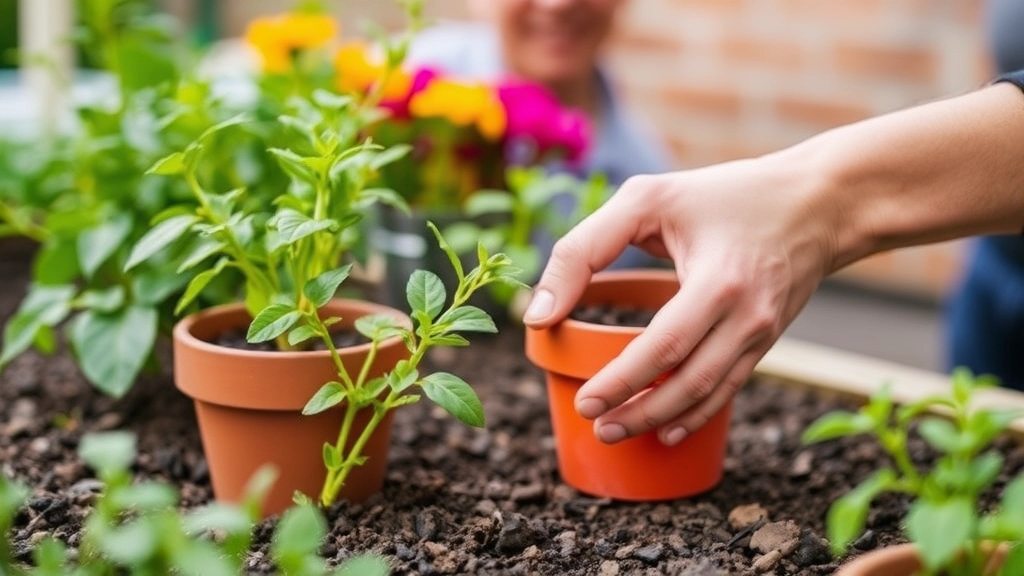
Let’s chat about why Kalanchoe plants are a dream for busy folks or those with a not-so-green thumb.
These little champs are tough as nails and won’t throw a fit if you forget about them for a bit.
Here’s why Kalanchoe is your new low-maintenance bestie:
- Drought-tolerant: They’re like camels, storing water in their thick leaves.
- Minimal watering: Once a week is plenty, maybe less in winter.
- Not fussy about light: They’ll thrive in bright spots but can handle some shade too.
- Slow-growing: No need for constant pruning or repotting.
- Pest-resistant: These plants aren’t on the menu for most common houseplant pests.
I’ve got a Kalanchoe blossfeldiana on my desk that’s been going strong for months with barely any attention.
It’s like having a plant on autopilot â perfect for when life gets hectic.
Pro tip: If you’re forgetful, Kalanchoe’s your plant pal. It’ll forgive you if you skip a watering or two.
Bottom line: Kalanchoe plants are the ultimate low-maintenance greenery for your space. If you’re interested in a unique variety, you might want to check out the Kalanchoe beharensis, also known as the Velvet Elephant Ear.
Emotional and Psychological Benefits
Let’s chat about the emotional and psychological benefits of Kalanchoe plants. Trust me, these little green buddies can do wonders for your mental state.
Mood Boosters
Ever walked into a room with plants and instantly felt better? That’s not just in your head. Kalanchoe plants can:
- Reduce stress levels
- Boost your mood
- Increase feelings of calm and relaxation
It’s like having a mini therapist on your windowsill, but way cheaper and doesn’t talk back!
Productivity Powerhouses
Here’s a cool trick: pop a Kalanchoe on your desk. Studies show that having plants in your workspace can:
- Improve concentration
- Boost creativity
- Increase productivity
Who knew procrastination could be beaten by a pot plant?
Connection to Nature
In our concrete jungles, it’s easy to feel disconnected from nature. Kalanchoe plants can:
- Bring a bit of the outdoors inside
- Help you feel more grounded
- Satisfy that primal need for green stuff
It’s like having a slice of the Amazon in your living room, minus the creepy crawlies.
Sense of Achievement
Growing and caring for a Kalanchoe can give you:
- A sense of purpose
- Feelings of accomplishment
- Improved self-esteem
It’s like being a plant parent, but without the 3 am feeds and nappy changes.
Mindfulness Practice
Tending to your Kalanchoe can be a form of mindfulness:
- Focuses your attention on the present moment
- Provides a break from digital overload
- Encourages a slower, more mindful pace
It’s meditation, but with dirt under your fingernails.
Look, at the end of the day, Kalanchoe plants aren’t just pretty faces. They’re working overtime to keep your head in a good place. So next time you’re feeling down, maybe what you need isn’t a tub of ice cream, but a nice little Kalanchoe plant. Your mind (and waistline) will thank you.
Kalanchoe in Traditional Medicine
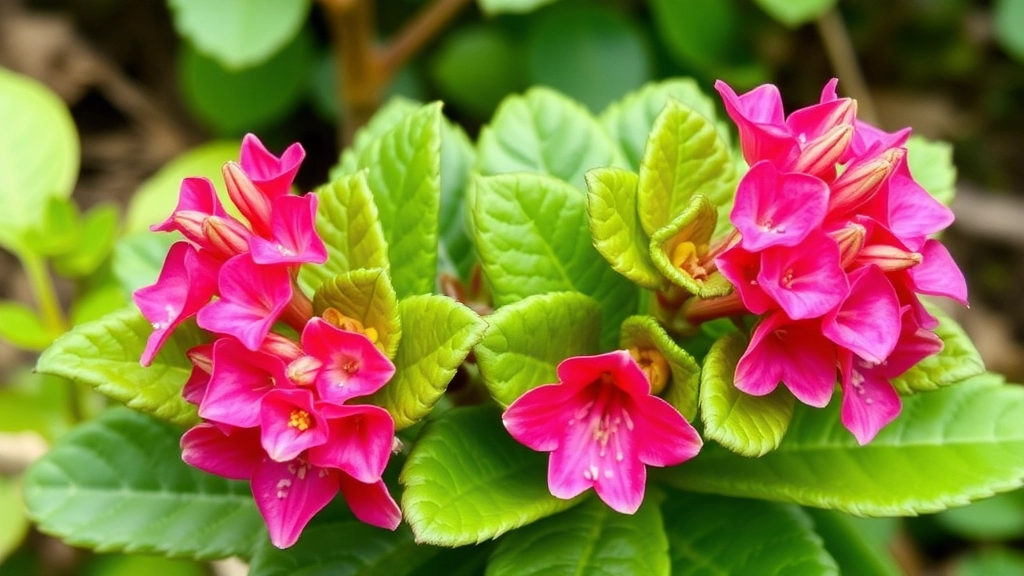
Kalanchoe’s been a big player in traditional medicine for ages.
Let’s dive into how our ancestors used this powerhouse plant.
Ancient Wisdom Meets Modern Curiosity
People have been turning to Kalanchoe for centuries.
It’s not just a pretty face in your garden.
This plant’s got some serious healing cred.
What’s the Deal with Kalanchoe?
- It’s been used to treat everything from infections to inflammation.
- Some cultures swear by it for wound healing.
- Others use it to calm digestive issues.
But here’s the kicker: it’s not just old wives’ tales.
Modern science is starting to back up some of these claims.
A Global Healer
From Africa to Asia, Kalanchoe’s been a go-to remedy.
In Madagascar, they’ve used it for ages to boost the immune system.
Chinese medicine? Yep, they’re fans too.
They’ve used it to treat respiratory issues.
The Secret Sauce
It’s all about the plant’s compounds.
Flavonoids, alkaloids, you name it.
These natural chemicals pack a punch.
They’re what give Kalanchoe its healing mojo.
Word of Caution
Before you go all-in on Kalanchoe, remember:
- Traditional doesn’t always mean safe for everyone.
- Always chat with a doc before trying new remedies.
- Some Kalanchoe species can be toxic if misused.
The Future of Kalanchoe in Medicine
Scientists are digging deeper into Kalanchoe’s potential.
Who knows? It might just be the next big thing in natural medicine.
But for now, it’s a fascinating glimpse into how our ancestors tackled health issues.
Kalanchoe in traditional medicine isn’t just history â it’s a bridge to future discoveries. One particularly interesting species is the Kalanchoe pinnata, which has been used in various traditional remedies. Another popular variety, the Kalanchoe blossfeldiana, is not only medicinal but also widely cultivated for its ornamental value.
How to Care for Your Kalanchoe Plant
Alright, let’s chat about keeping your Kalanchoe happy and thriving. These little beauties are pretty chill, but they’ve got a few needs we can’t ignore. Trust me, I’ve learned the hard way!
Light: The Goldilocks Zone
Your Kalanchoe’s not fussy, but it’s got a sweet spot for light:
- Bright, indirect sunlight is the jackpot
- Too much direct sun? You’ll see crispy leaves
- Not enough light? Say goodbye to those vibrant blooms
Pro tip: A south-facing window with a sheer curtain is perfect. It’s like giving your plant sunglasses!
Water: Less is More
Here’s where most folks mess up. Kalanchoes are succulents, so they’re drought-tolerant champs:
- Let the soil dry out between waterings
- Stick your finger in the soil – if it’s dry 2 inches deep, it’s watering time
- In winter, cut back even more
Remember: It’s easier to save an underwatered Kalanchoe than an overwatered one. When in doubt, hold off.
Soil and Potting: Keep it Loose
Your Kalanchoe’s not into heavy, waterlogged soil. It’s like trying to run in mud – no fun!
- Use a well-draining potting mix
- Add some perlite or sand for extra drainage
- Make sure your pot has drainage holes
Feeding: A Little Goes a Long Way
These plants aren’t big eaters, but a little boost now and then doesn’t hurt:
- Feed with a balanced, water-soluble fertiliser
- Do it once a month during growing season
- Skip the fertiliser in winter when growth slows down
Temperature: Comfort is Key
Kalanchoes like it warm, but not too hot:
- Ideal range: 15-25°C (60-75°F)
- They can handle a bit cooler at night
- Protect from drafts and sudden temperature changes
Pruning: Keeping it Tidy
A little snip here and there keeps your Kalanchoe looking sharp:
- Remove dead or yellowing leaves
- Pinch off spent blooms to encourage more flowers
- If it’s getting leggy, don’t be afraid to give it a haircut
Pests: Stay Vigilant
Keep an eye out for uninvited guests:
- Mealybugs and spider mites are the usual suspects
- Wipe leaves with a damp cloth regularly
- If you spot pests, isolate the plant and treat with neem oil
Remember, caring for a Kalanchoe isn’t rocket science. It’s about finding that sweet spot between neglect and helicopter plant parenting. Get to know your plant, and you’ll be rewarded with a happy, blooming buddy that brightens up your space. Now, go give your Kalanchoe some love!
Common Varieties of Kalanchoe: A Colourful Journey
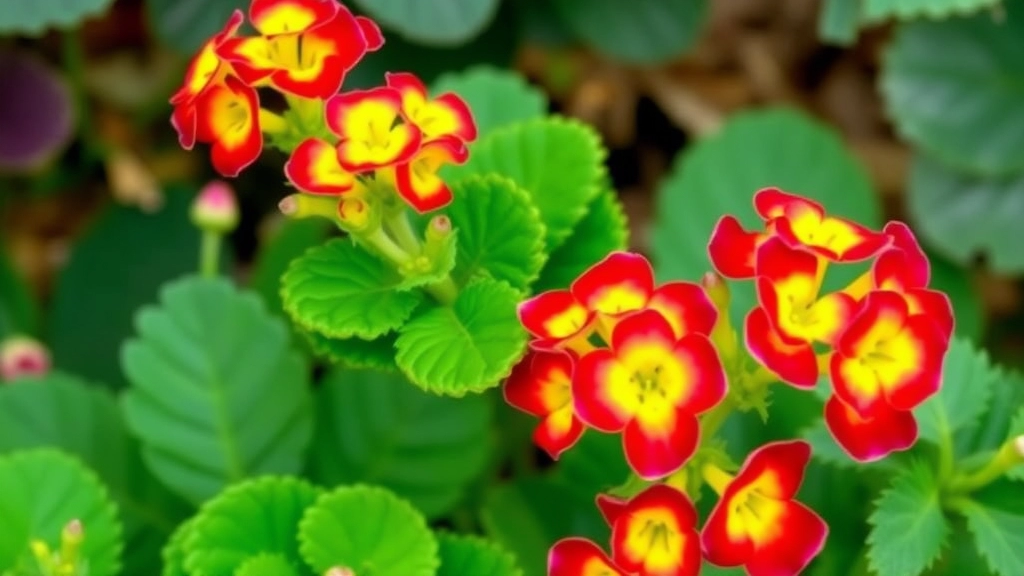
Ever wondered about the different types of Kalanchoe out there?
Let’s dive into this vibrant world together.
Kalanchoe blossfeldiana: The Superstar
This one’s the crowd-pleaser, folks.
Bright flowers, glossy leaves – it’s the whole package.
You’ll spot it in homes, offices, and even as a cheeky gift.
Kalanchoe tomentosa: The Panda Plant
Fuzzy leaves that feel like velvet?
Yep, that’s this quirky little number.
It’s like having a cuddly pet, minus the vet bills.
Kalanchoe thyrsiflora: The Flapjack Plant
Imagine pancakes stacked on a stem.
That’s what this beauty looks like.
Its leaves turn red in bright light – talk about a showstopper!
Kalanchoe daigremontiana: The Mother of Thousands
This one’s a bit of a rebel.
It drops baby plants from its leaves like it’s no big deal.
Perfect for those who want an ever-growing Kalanchoe family.
Kalanchoe beharensis: The Felt Bush
Massive leaves covered in soft fuzz?
Check, check, and check.
It’s like nature’s version of a cosy blanket.
Kalanchoe pumila: The Flower Dust Plant
Tiny silver leaves that look like they’ve been dusted with fairy powder.
It’s the plant equivalent of a glitter bomb, but way classier.
So, there you have it – a quick tour of some common Kalanchoe varieties.
Each one’s got its own personality, just waiting to jazz up your space.
Which Kalanchoe blossfeldiana family variety caught your eye? If you’re interested in unique varieties, you might want to check out the Kalanchoe beharensis cv. Fang for something truly special.
Tips for Growing Kalanchoe Indoors
Growing Kalanchoe indoors? You’re in for a treat. These succulents are tough little cookies that can brighten up any room. Let’s dive into some no-nonsense tips to keep your Kalanchoe thriving.
Light It Up
Kalanchoes love the sun, but they’re not beach bums. Here’s the deal:
- Aim for bright, indirect light
- A south-facing window is ideal
- If leaves start yellowing, it’s getting too much sun
- Not enough flowers? It might need more light
I once put my Kalanchoe in a dark corner, thinking it’d be fine. Spoiler alert: it wasn’t. The poor thing got all leggy and sad. Lesson learned!
Water Wisely
These guys are succulents, so they’re pretty chill about water. But there’s a sweet spot:
- Let the soil dry out between waterings
- Stick your finger in the soil – if it’s dry 2 inches deep, it’s watering time
- Water thoroughly, but don’t let it sit in water
- In winter, cut back on watering
Temperature Tricks
Kalanchoes aren’t too fussy about temperature, but they do have preferences:
- They’re happiest between 15-21°C (60-70°F)
- Can handle a bit cooler at night
- Keep them away from drafts and heating vents
Soil and Pots
Getting the right setup is key:
- Use well-draining potting mix
- Add some perlite or sand for extra drainage
- Choose a pot with drainage holes
- Don’t go too big – they like to be a bit snug
Feeding Your Kalanchoe
These plants aren’t big eaters, but a little boost helps:
- Feed with a balanced, water-soluble fertiliser
- Do this every 2-3 months during growing season
- Skip the fertiliser in winter
Pruning and Maintenance
Keep your Kalanchoe looking sharp:
- Pinch off dead flowers to encourage more blooms
- Trim leggy stems to keep it bushy
- Remove any yellowing or dead leaves
Dealing with Pests
Even indoor plants can get uninvited guests:
- Keep an eye out for mealybugs and spider mites
- If you spot any, wipe leaves with rubbing alcohol
- For serious infestations, use an insecticidal soap
Encouraging Blooms
Want more flowers? Here’s a trick:
- Give your Kalanchoe 14 hours of complete darkness each night for 6 weeks
- This mimics winter conditions and triggers blooming
- After that, return to normal light conditions
Remember, growing Kalanchoe indoors isn’t rocket science. These plants are pretty forgiving, so don’t stress too much. Just give them some light, don’t drown them, and they’ll reward you with beautiful blooms. And if you mess up? No worries. These tough little plants can bounce back from most rookie mistakes. Trust me, I’ve made plenty!
Seasonal Benefits of Kalanchoe
Ever wondered why Kalanchoe plants are such a hit year-round?
Let me break it down for you.
These little powerhouses pack a punch in every season.
Spring: Kalanchoe bursts into life
- Vibrant blooms add a pop of colour to your space
- Perfect for brightening up dreary post-winter days
- Helps kickstart your gardening mojo
Summer: Kalanchoe keeps its cool
- Thrives in warm weather, unlike some fussy plants
- Drought-resistant, so no stress if you forget to water
- Great for outdoor patios or balconies
Autumn: Kalanchoe brings the cosy vibes
- Indoor blooms when outdoor gardens start to fade
- Warm colours complement autumn decor
- Helps fight off the seasonal blues
Winter: Kalanchoe keeps on giving
- Flowers during the darkest months
- Adds life to holiday decorations
- Boosts mood during gloomy weather
But here’s the kicker:
Kalanchoe’s air-purifying skills work overtime in winter when we’re cooped up indoors.
It’s like having a natural air freshener that looks good too.
Pro tip: Rotate your Kalanchoe blossfeldiana’s position each season for optimal growth and blooming.
Bottom line: Kalanchoe’s seasonal benefits make it a year-round winner for any home or office. If you’re looking for a unique variety, consider the Kalanchoe beharensis ‘Fang’ for its distinctive appearance.
Kalanchoe as a Gift Plant
Kalanchoe as a gift plant? Absolutely! Let me tell you why these little beauties are my go-to when I need to impress someone without breaking the bank.
First off, kalanchoes are like the Swiss Army knife of gift plants. They’re versatile, low-maintenance, and pack a visual punch that’ll make anyone’s day. Here’s why I love giving them:
- They’re tough cookies: Forget about your friend with the “black thumb” – kalanchoes can take a beating and still look fab.
- Colour explosion: These plants come in so many shades, you’ll feel like you’re handing over a rainbow.
- Long-lasting joy: Unlike cut flowers that wilt in a week, kalanchoes keep on giving for months.
Now, let’s chat about when to give these beauties:
Housewarming Parties
Nothing says “welcome home” like a pop of colour. A kalanchoe brightens up any new space without demanding too much attention.
Birthdays
Skip the predictable bouquet and go for a living plant that’ll remind your mate of you every time they water it (which isn’t often, by the way).
Get Well Soon
Hospitals can be drab. A kalanchoe brings life to those sterile rooms and doesn’t need much care while your friend focuses on recovery.
Valentine’s Day
Roses are red, violets are blue, but kalanchoes are unique – just like you! Trust me, it’s a refreshing change from the usual suspects.
Office Gifts
Your co-worker’s desk could use some life. A small kalanchoe fits perfectly and might even boost their productivity (no promises, though).
Here’s a pro tip: pair your kalanchoe with a quirky pot or add a personal touch like a hand-written care tag. It’s these little details that turn a simple plant into a memorable gift.
Remember, giving a kalanchoe isn’t just about the plant – it’s about sharing a bit of nature, a splash of colour, and a whole lot of good vibes. So next time you’re scratching your head over what to give, think kalanchoe. It’s the gift that keeps on growing!
Environmental Impact of Growing Kalanchoe
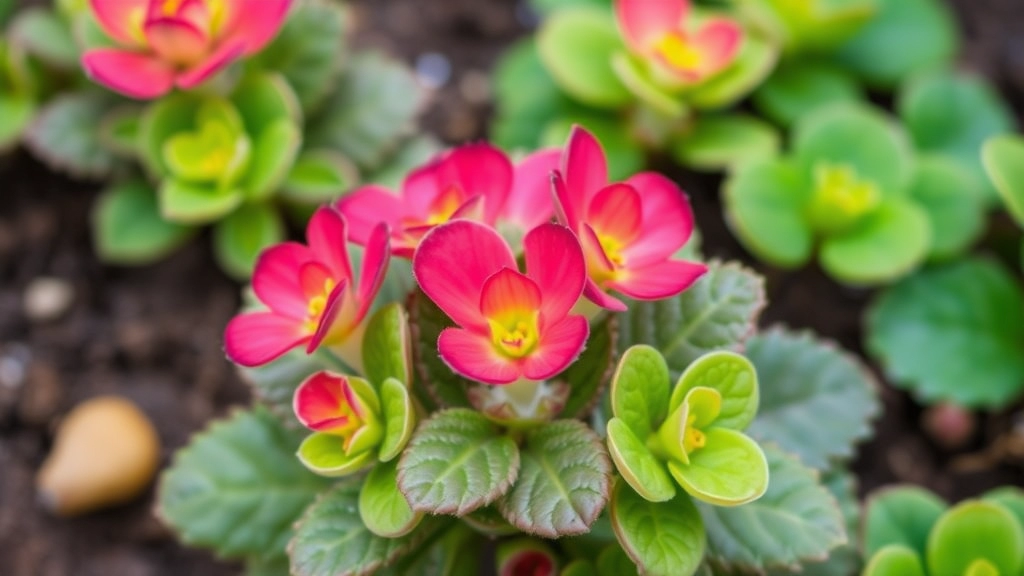
Ever wondered about the eco-footprint of your Kalanchoe?
Let’s dive into the green side of these succulents.
Kalanchoe plants are pretty chill when it comes to the environment.
They’re not water hogs, which is a big win in my book.
Less water means less strain on our resources.
These plants are tough cookies, thriving in various conditions.
That means fewer chemicals and pesticides needed. Score!
Indoor air quality? Kalanchoe’s got your back.
They’re natural air purifiers, filtering out nasties from your space.
But here’s the kicker – they’re not invasive in most places.
You won’t find Kalanchoe running wild and messing up local ecosystems.
Growing them at home? You’re actually helping reduce carbon footprint.
How? By cutting down on transport emissions from store-bought plants.
Plus, they’re long-lasting. Less waste, more green goodness.
But heads up – some Kalanchoe species have medicinal uses. Always research before bringing any plant home.
Overall, Kalanchoe is a solid choice for eco-conscious plant lovers.
They’re low-impact, high-reward plants that keep on giving.
So, go ahead and green up your space with flowering Kalanchoe blossfeldiana – Mother Nature approves!
Frequently Asked Questions about Kalanchoe
Hey there, plant lovers! Let’s dive into some common questions about Kalanchoe.
Are Kalanchoe plants toxic to pets?
Yep, they can be. Keep ’em out of reach of your furry friends.
How often should I water my Kalanchoe?
Less is more here. Wait till the soil’s dry before giving it a drink.
Can Kalanchoe grow outdoors?
Sure can! They love warm spots with some shade.
Why are my Kalanchoe leaves turning yellow?
Could be overwatering or too much sun. Ease up on the H2O and find a shadier spot.
How long do Kalanchoe flowers last?
These beauties can bloom for weeks, sometimes even months!
Can I propagate Kalanchoe from leaves?
Absolutely! It’s super easy. Just pop a leaf in some soil and watch it grow.
Do Kalanchoe plants need fertilizer?
A bit during growing season won’t hurt, but don’t go overboard.
How big do Kalanchoe plants get?
Most stay pretty compact, perfect for small spaces.
Can Kalanchoe survive in low light?
They’ll manage, but might not flower as much. Bright indirect light is best.
Are there any rare Kalanchoe varieties?
Oh yeah, some collectors go nuts for the unusual ones!
Remember, Kalanchoe care is all about finding that sweet spot.
Keep it simple, watch your plant, and you’ll be golden.
Got more questions about Kalanchoe? Fire away in the comments!
Here is a FAQ section based on the article content and keywords:
Frequently Asked Questions about Kalanchoe
What are the main benefits of having a Kalanchoe plant?
Kalanchoe plants offer several benefits:
– They are natural air purifiers, improving indoor air quality
– They can boost mood and reduce stress
– They are low-maintenance and easy to care for
– They provide colorful blooms that last for weeks or months
– Some varieties have potential medicinal properties
How often should I water my Kalanchoe?
Kalanchoe plants are drought-tolerant succulents. Let the soil dry out completely between waterings. Generally, watering once a week is sufficient, and even less in winter. Overwatering is more harmful than underwatering for these plants.
What kind of light does a Kalanchoe need?
Kalanchoe plants thrive in bright, indirect light. A south-facing window with a sheer curtain is ideal. They can tolerate some direct morning sun but should be protected from harsh afternoon sunlight. Too little light may result in fewer blooms.
Are Kalanchoe plants safe for pets?
No, Kalanchoe plants can be toxic to pets if ingested. It’s best to keep them out of reach of cats, dogs, and other animals. If you suspect your pet has eaten any part of a Kalanchoe, contact your veterinarian immediately.
How can I encourage my Kalanchoe to bloom?
To encourage blooming:
– Ensure it gets enough bright, indirect light
– Allow for a period of dormancy in winter with cooler temperatures and less water
– Provide 14 hours of complete darkness each night for 6 weeks to trigger blooming
– Fertilize lightly during the growing season
– Remove spent blooms to promote new flower growth
Can Kalanchoe plants be grown outdoors?
Yes, Kalanchoe plants can be grown outdoors in warm climates (USDA zones 10-12). They prefer partial shade and well-draining soil. In colder regions, they can be moved outdoors during summer but should be brought inside before temperatures drop below 50°F (10°C).
What are some common varieties of Kalanchoe?
Some popular Kalanchoe varieties include:
– Kalanchoe blossfeldiana (Flaming Katy)
– Kalanchoe tomentosa (Panda Plant)
– Kalanchoe thyrsiflora (Flapjack Plant)
– Kalanchoe daigremontiana (Mother of Thousands)
– Kalanchoe beharensis (Felt Bush)
– Kalanchoe pumila (Flower Dust Plant)
How do I propagate my Kalanchoe plant?
Kalanchoe plants are easy to propagate:
– Take a leaf or stem cutting
– Allow the cut end to callus over for a few days
– Plant in well-draining soil
– Keep the soil slightly moist until roots develop
– Once established, treat as a mature plant
References
-
NASA Clean Air Study Interior Landscape Plants for Indoor Air Pollution Abatement
-
Kalanchoe in Traditional Medicine Kalanchoe species: Review of ethnobotany, phytochemistry and pharmacology
-
Kalanchoe Varieties Kalanchoe Plant Profile

